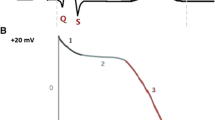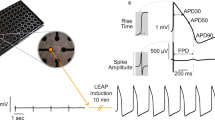Abstract
Microelectrode array (MEA) is an electrophysiological instrument used to track activities of ion channels in excitable cells. Neurons and cardiomyocytes are seeded to form a cell monolayer on a field of sensors able to detect electrical signals, called extracellular field potentials (EFPs). This noninvasive tool allows researchers to investigate key parameters such as EFP amplitude, duration, and arrhythmias. MEA is progressively considered the gold standard for high-throughput in vitro electrophysiological evaluation, particularly for cardiac disease modeling and cardiac toxicity assessment.
Access this chapter
Tax calculation will be finalised at checkout
Purchases are for personal use only
Similar content being viewed by others
References
Li X, Zhang R, Zhao B, Lossin C, Cao Z (2016) Cardiotoxicity screening: a review of rapid-throughput in vitro approaches. Arch Toxicol 90(8):1803–1816
Kussauer S, David R, Lemske H (2019) hiPSCs derived cardiac cells for drug and toxicity screening and disease modeling: what micro- electrode-array analyses can tell us. Cell 8(11):1331
Takasuna K, Asakura K, Araki S et al (2017) Comprehensive in vitro cardiac safety assessment using human stem cell technology: overview of CSAHi HEART initiative. J Pharm Tox Met 83:42–54
Blinova K, Dang Q, Millard D et al (2018) International multisite study of human-induced pluripotent stem cell-derived cardiomyocytes for drug proarrhythmic potential assessment. Cell Rep 24(13):3582–3592
Wu JC, Garg P, Yoshida Y et al (2019) Towards precision medicine with human iPSCs for cardiac channelopathies. Circ Res 125(6):653–658
Prondzynski M, Lemoine MD, Zech AT et al (2019) Disease modeling of a mutation in α-actinin 2 guides clinical therapy in hypertrophic cardiomyopathy. EMBO Mol Med 11(12):e11115
Kannankeril PJ, Norris K, Carrter S, Roden DM (2012) Factors affecting the degree of QT prolongation with drug challenge in a large cohort of normal volunteers. Heart Rhyt 8(10):1530–1534
Burridge PW, Matsa E, Shukla P et al (2014) Chemically defined and small molecule-based generation of human cardiomyocytes. Nat Methods 11(8):855–860
Giudiscessi JR, Ackerman MJ, Camilleri M (2018) Cardiovascular safety of prokinetic agents: a focus on drug-induced arrhythmias. Neur Motil 30(6):e13302
Citi S (2019) The mechanobiology of tight junctions. Biophys Rev 11(5):783–793
Clements IP, Millard DC, Nicolini AM et al (2016) Optogenetic stimulation of multiwell MEA plates for neural and cardiac applications. Clin Trans Neur:96902C
Kijala K, Ahola A, Pekkanen-Mattila M et al (2012) Electrical field stimulation with a novel platform: effect on cardiomyocyte gene expression but not on orientation. Int J Biomed Sci 8(2):109–120
Veerman CC, Mengarelli I, Lodder EM et al (2017) Switch from fetal to adult SCN5A isoform in human induced pluripotent stem cell-derived cardiomyocytes unmasks the cellular phenotype of a conduction disease-causing mutation. J Am Hear Asso 6(7):pii: e005135
Solaro CR, Lingle CJ (1992) Trypsin-sensitive, rapid inactivation of a calcium-activated potassium channel. Science 257(5077):1694–1698
Peyronnet R, Nerbonne JM, Kohl P (2016) Cardiac mechano-gated ion channels and arrhythmias. Circ Res 118(2):311–329
Mangold KE, Brumback BD, Angsutararux P et al (2017) Mechanisms and models of cardiac sodium channel inactivation. Channels 11(6):517–533
Acknowledgments
This work was supported by NIH R01 HL113006, R01 HL123968, and AHA 17MERIT3610009. We also thank Axion Biosystems for documentation and allowing us to use the Maestro MEA system as an example.
Author information
Authors and Affiliations
Corresponding author
Editor information
Editors and Affiliations
Rights and permissions
Copyright information
© 2022 Springer Science+Business Media, LLC, part of Springer Nature
About this protocol
Cite this protocol
Belbachir, N., Cunningham, N., Wu, J.C. (2022). High-Throughput Analysis of Drug Safety Responses in Induced Pluripotent Stem Cell-Derived Cardiomyocytes Using Multielectrode Array. In: Coulombe, K.L., Black III, L.D. (eds) Cardiac Tissue Engineering. Methods in Molecular Biology, vol 2485. Humana, New York, NY. https://doi.org/10.1007/978-1-0716-2261-2_7
Download citation
DOI: https://doi.org/10.1007/978-1-0716-2261-2_7
Published:
Publisher Name: Humana, New York, NY
Print ISBN: 978-1-0716-2260-5
Online ISBN: 978-1-0716-2261-2
eBook Packages: Springer Protocols




